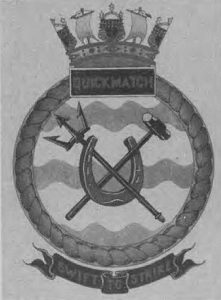- Author
- Farnsworth, Lieutenant-Commander (E) R. T. RAN
- Subjects
- Ship histories and stories
- Tags
-
- RAN Ships
- HMAS Quentin, HMAS Quickmatch, HMAS Quiberon
- Publication
- December 1974 edition of the Naval Historical Review (all rights reserved)

It is with some trepidation that I pick up my pen to try and describe some of my impressions during the time I ‘stood by’ the building of Quickmatch; but I feel they may be of interest to my shipmates in a ship of which I am inordinately proud; albeit they must of necessity be strictly personal ones.
ARRIVING IN LIVERPOOL on a really foul day early in January 1941, with a drizzling rain and a biting wind, my first feeling was one of depression, and I started a fit of shivering that was not to stop for some two months.
London was bitterly cold, and I was thankful to find that Quickmatch was building in the Isle of Wight; at least it was a bit nearer to the Equator. Funny to think of heat now!
Alas, this proved to be merely a fond hope, there was a snowstorm in progress when I arrived at Cowes and about two feet of snow on the roads. No! I did not stop shivering. People said that it was a cold winter certainly, in fact you didn’t often see snow in Cowes; and anyhow, they supposed my blood was a bit thin! It was!
J. Samuel White and Co. Ltd. proved to be a small firm doing a staggering amount of work. There were three ‘Q’ destroyers in hand, Quentin fitting out, Quiberon and Quickmatch still on the slips, as well as an SGB and two Hunts. ‘Yours is that rustylooking job,’ I was told, and saw our floating palace of today as a lot of ribs sticking up from the ways with the bow and stern plating missing, and she did look rusty – very!
Nobody seemed to be interested in her at all, and when I walked round, I could only see about half a dozen men who seemed rather bored with a bit of plating that they were riveting to the frames.
But by some peculiar agency, and it still remains a shipbuilding mystery to me, one could see her growing day by day. As no work could be done by night on the hull, I suppose these bored gentlemen just whipped plates on when nobody was looking!
In the shops, our engines were still in a very elementary stage, and here again, it never ceased to astonish me the way in which a lot of rough pieces of metal rapidly became a boiler or a turbine.
The office I was given had no central heating, but there was a stove that didn’t work and filled the office with smoke – as still shivering heavily.
The Isle of Wight, up to this time, had received no damage from the activities of the Hun, beyond a few craters in deserted parts of the island, but had had a grandstand view of the blitzes on Portsmouth and Southampton, so that Cowes remained intact.
What a funny little town Cowes is, or rather was! The impression one got was that Queen Victoria, as far as the inhabitants were concerned, was still alive, and might be down for a weekend at any time. They are an insular lot on the island and a trip to the ‘mainland’ is quite firmly ‘going foreign’. I heard one old man in a Newport pub one night say that it was the first time he had been into the town for five years – his farm was about seven miles away.

Food was plentiful if a bit dull; one certainly did not go hungry; but an honest-to- goodness grilled steak of proper size became my idea of heavenly manna before very long, especially with all this shivering.
England was at this time in rather a mixed frame of mind; Pearl Harbour had occurred and the Americans were now in the show; Hong Kong, Singapore, Prince of Wales and Repulse had gone. At home, the ‘Battle of Britain’ had been won, raids were infrequent and, in general, slight. Nobody thought for a second that we could ever lose, but it looked a long struggle ahead; although, as I said, the war had not come to Cowes – it did!
One morning there was a burst of firing from the hill behind Osborne, a few heavy ‘crumps’, and then the sirens went. Two fighter bombers, ‘hit and run’ raiders, had done their stuff.
Not very much damage was caused in this show. A bomb exploded in White’s pattern store and that burnt quickly and efficiently, another landed in the plate shop, bounced out into the road, and exploded there. The Polish destroyer Blyscawyka, then refitting just above the fitting-out wharf, had a narrow escape when a bomb burst at the end of her gangway and lifted it over the ship, taking her mast with it. Only one man was killed in the ship, but she certainly saved White’s with her steady and accurate Bofors firing.




